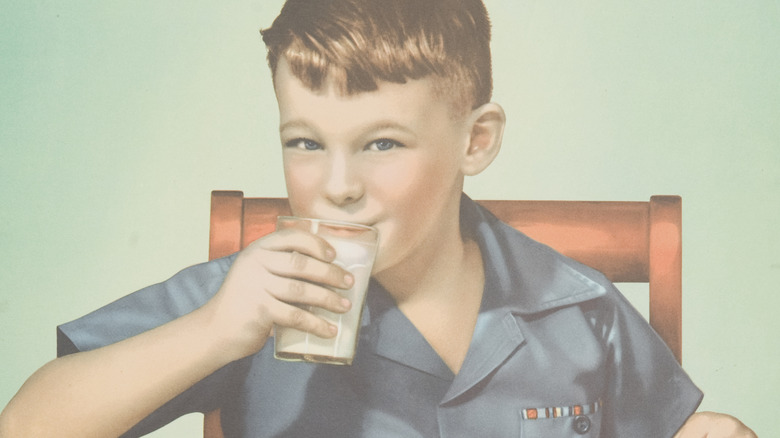Why Do Americans Drink Milk With Dinner?
It's cold, creamy, and delicious — and some don't even think twice about pouring that daily dose of the calcium-rich beverage with their weeknight meals. But why, exactly, did it become so popular for Americans to drink milk with dinner?
We see milk as something of a star even in the very early history of dairy in America; many brought cattle as they settled in the country, and the family's milk cow was a go-to source of sustenance. But, if we condense it, there were some major influences that contributed to milk becoming a dinner-time staple in the U.S. During World War I, more milk was being produced because the U.S. government sent supplies of evaporated milk as rations to soldiers. This led to an overproduction that continued after the war was over, and the abundance of milk meant it was available at lower prices.
Along with its widespread availability, scientists gained new understanding of the nutritional value of milk. It was advertised as an important and near-perfect food, a key source of nutrition, especially for children. Milk also became more popular and appealing as advances were made in the dairy industry itself, such as pasteurization and transportation processes. Add in the fact that milk was promoted as a patriotic food, and it's easy to see why milk began gracing American dinner tables each night. It was not only nutritious, affordable, and easy to get, but, in many ways, it represented progress and patriotism.
Milk was an icon of progress and nutrition for American families
Inventions involving milk production contributed to its place at the American dinner table, making it safer and more widely available. For example, the Mehring Milking Machine was an early invention that helped streamline the process. Other important developments in the dairy industry during the late nineteenth and early twentieth centuries involved pasteurization, sanitizing, and delivery. Automatic bottle machines and mechanical washers improved distribution while refrigerated train cars, and later, milk haulers, made milk easier to transport.
In the early twentieth century, the USDA highlighted milk's high nutritional value, and this had a positive impact on America's relationship with milk. It was advertised as an optimal source of nutrition for not only infants and children but for people of all ages. Having several servings of milk daily became seen as a daily necessity, so it grew to be commonplace to have milk with dinner.
People were also encouraged to drink milk because it was an all-American food. The emphasis on patriotism and national identity saw a resurgence during WWII as well, with government slogans even printed on milk bottles. American dairies were seen as supporting the war efforts and the health of the American people. Continued innovation in the dairy industry, coupled with the emphasis on nutrition and its association with patriotism, turned milk into something of an American icon. It wasn't just a beverage; it was a symbol of America and its ability to persevere and lean into progress.
Milk around the dinner table then and now
Currently, the USDA recommends that adults as well as children nine and older have three cups of dairy daily (and 1 ⅔ cups to 2 ½ cups for children under nine, depending on age). The guidelines also state that 90% of Americans don't get adequate dairy in their diet. So, pouring a glass of milk with dinner can be a simple way to increase dairy intake and get nutrients like calcium, vitamin D, and phosphorus.
Plain milk has powerful hydration benefits, is easily available, requires zero prep, and packs a nutritional punch. Plus, it's so versatile that you can use it for anything from your morning bowl of cereal to soaking your salmon for a milder taste. These benefits contribute to milk continuing to be a staple in many American households.
However, the consumption of milk in the U.S. has had a downward trend over the past seven decades, so drinking cow's milk around the dinner table isn't as iconic as it once was. Contributing factors include changes in American eating habits, increased availability of plant-based milk, and more knowledge related to dairy allergies. So, while you're still likely to see plenty of families drinking dairy milk around the dinner table, the truth about milk is that it's not the only calcium-rich option. Whether you're sipping almond milk, calcium-fortified OJ, or some other beverage at your next family dinner, it can be just as American and nutritious as a cup of cow's milk.



